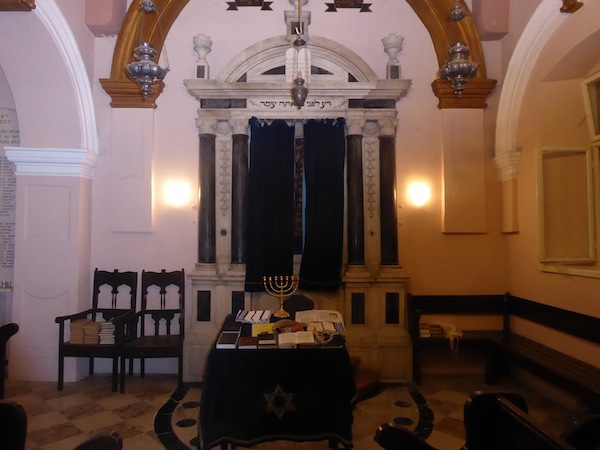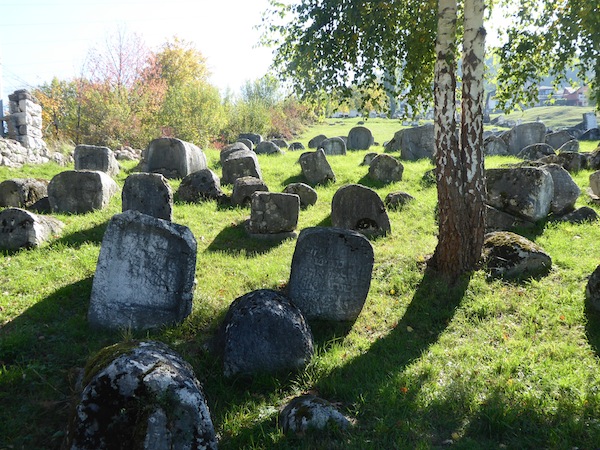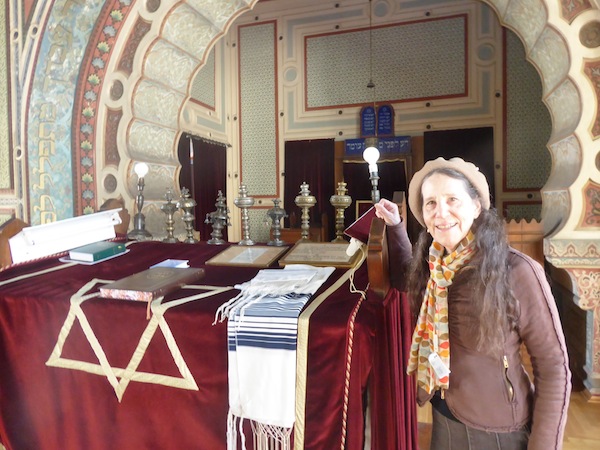The author in the synagogue in Sarajevo, Bosnia-Herzegovina. (photo from Miri Garaway)
When I first started planning and researching our October 2017 trip to Slovenia, Croatia and Bosnia-Herzegovina, the foremost thing on my mind was learning about the Jewish history of the region. It was uncharted travel territory for me and I was curious to uncover the areas that were once vibrant Jewish communities.
Rather than being herded around by bus on a large organized tour and staying in North American-type hotels, which are far away from the pedestrian-only “Old Town” neighbourhoods of the cities, I wanted the challenge of researching centrally located, charming and historical bed and breakfasts and/or apartments and then finding private or small group Jewish heritage tours within each place. This proved to be an interesting process, whereby I delved into several possibilities. I left no stone unturned in designing this journey and it was such a feeling of exhilaration to put it all together and enjoy it.
Once I decided on accommodations in each city, I then had the task of transportation. To save time and energy, I hired a series of private drivers. This proved to be a wise decision, as 17 days does not allow for a slow pace. An added bonus was having our driver appear at the hotel, take our luggage and drop us off at our next destination, stopping to tour along the way, if we desired.
By pure chance, I had come across a U.K.-based company called mydaytrip.com – they responded promptly, were professional and easy to deal with and I had full confidence that I made the right choice. In addition to hiring a private driver, I also discovered a private tour company (based in Vancouver) called toursbylocals.com – their in-depth walking tours were excellent and I would highly recommend them.
Another option I used was Viator, a subsidiary of Tripadvisor. They offer a variety of small group (maximum eight people) tours all over the world and they liaise with local travel agencies, which provide the service. It is a great way to have various tour options at a reasonable cost.
Our first stop was Ljubljana, Slovenia, a charming university town of friendly people, exquisite Baroque architecture, a delightful cobblestoned Old Town and a vibrant café culture. Most notable is the Kaverna Zvezda, the best pastry café in town, featuring the traditional kremna rezina, also known as cremeschnitz, cream and custard between layers of puff pastry, which I had also tried in Israel. In short – divine. The gibanica (pronounced gabanitza), a delicious cake with poppy seeds, curd cheese, walnuts and apples, is another legendary cake in Slovenia and reminded me of a cake my Eastern European grandmother made. She was from Czernowitz, Austria-Hungary.
Pumpkin seed oil is “king” here and is used with the same frequency as olive oil is in Italy. Vegetarian pumpkin soup is on every menu, much to my delight. Were there any remnants of a Jewish community here? This seemed like Jewish comfort food to me.
Documents show that Jews settled in Ljubljana from the 13th century onward and worked as merchants, bankers, artisans and some as farmers. They had a synagogue, a school and a rabbinical court. In 1515, the Roman emperor Maximillian expelled the Jews and Ljubljana’s Jewish Quarter disappeared.
As I walked down the two narrow streets in the Old Town, that once housed a small Jewish community – Zidovska ulica and Zidovska steza, Jewish Street and Jewish Lane – the only sign of a Jewish presence was a vacant stone indentation on a building where a mezuzah had once stood.
Maribor, the second largest city in Slovenia, has a synagogue, but, unfortunately, it sits empty. Jews were also expelled from here, in 1496, though, eventually, both Ljubljana and Maribor regained their Jewish communities – until the Second World War. Then the Holocaust took its toll.
On a positive note, a synagogue did open in Ljubljana in 2003, but it is now part of the Jewish Cultural Centre. Ljubljana was previously the only European capital lacking a Jewish house of worship. The city does not have a rabbi, but the chief rabbi for Slovenia, Rabbi Ariel Haddad, resides in nearby Trieste, Italy.
* * *
Split, Croatia, once had a vibrant Jewish community, so, after visiting the Dalmatian coastal town of Zadar, we headed a little further south to Split, stopping first at the World UNESCO Heritage Site of Trogir.
In Split, I had arranged for a private guide, Lea Altarac, to meet us and give us a Jewish history tour as well as a general city walking tour. In 3.5 hours, we covered a lot. Lea is a teacher; extremely knowledgeable and proud of her city. Her mother is Bosnian and her father is Jewish; she has a Jewish soul, albeit one that does not practise Judaism. Nevertheless, she was eager to enlighten us with some of the Jewish history of the city.
We first toured Diocletian’s Palace in the Old Town and Lea pointed out the many Magen Davids etched into the stone. Once we had finished touring the extensive palace, we walked to the edge of the Old Town. There, we came across the small synagogue of Split, no exterior decoration to distinguish it, which is maintained as a museum by Lea’s father. As we climbed the stairs to the second floor of the old stone building, I tried to visualize it teeming with congregants, sadly no more.
One of the oldest European synagogues, it was created in the 16th century. The interior dates back to 1728. That was the first restoration of several, and when the mechitzah (partition between men and women in an Orthodox shul) was added. It is interesting to note that the ark was built into the western wall of the palace.
The synagogue was plundered by fascist fanatics in 1942 and, unfortunately, many valuable ritual books, archives and silver objects were burned or stolen.
In 1996, during another restoration, a commemoration plaque of local victims of the Holocaust was given to the synagogue as a gift from the Israeli ambassador.
There is no official rabbi for the synagogue in Split, but the rabbi from Zagreb, Croatia, comes about twice a year.

During archeological excavations carried out in the area of the Roman city of Salona, the capital of the Roman province of Dalmatia and the parent city of Split, traces of an established Jewish community were found. When Salona was destroyed, in the early seventh century, the surviving Jewish members took refuge within the walls of Diocletian’s Palace. This settlement was the early beginning of the city of Split.
The term Zueca is used to describe the localities where Jewish tanners and dyers lived. This was a common trade for centuries. Other Jewish occupations included weaving, tailoring, the sale of cloth, the running of a bank, as well as the food business, which was not permitted to Jews elsewhere.
Via 16th-century documents, we learned that there were Spanish and Portuguese immigrants who settled in Split, which was a port for trade between the Republic of Venice, to which Split belonged to at that time, and the Ottoman Empire. Most notably, a Spanish Jew named Daniel Rodriga, short for Rodriguez, was responsible for promoting the development of trade between Europe and the countries in the east. Caravans were also used for the exchange of goods to Turkey and Asia, which Rodriga felt was safer. He conceived the idea of building a large quarantine area, a lazaretto, in the port of Split to house men and goods from the eastern countries, before ships took them to Venice and the rest of Europe.
There was no Jewish ghetto in Split, as the members of the Jewish community enjoyed civil liberty. It was not until the late 18th century, toward the end of Venetian rule, that a ghetto was formed, due to the influence of the clergy and the decline of the Venetian economy.
Our walking tour led us up a steep hill, Marjan Hill, where we were afforded a spectacular view of Split. Overlooking the city, in a forest-like setting, is the Jewish cemetery, one of the oldest Jewish cemeteries known. It was founded in 1573 and was used until 1946.
After the collapse of fascism in 1943 and before the occupation of Split by the German army, many of the younger Jews left Split and joined the resistance movement in partisan units. Jews who did not leave were rounded up by the Nazis and sent to forced labour and concentration camps. Only one-third of the community survived and returned to Split after the liberation; others emigrated to Israel.
* * *
Sarajevo was our next stop, with a visit to Mostar on the way. Mostar, in Bosnia-Herzegovina, is a picturesque city situated on the Neretva River, only a two-hour drive from Split. I arranged a walking tour for the morning and asked the tour guide if we could visit the proposed site of a new synagogue. The small patch of land was donated by Zoran Mandlbaum, head of Mostar’s 45-member Jewish community, in the hopes that a synagogue would be built there. His vision was a building made of glass, symbolizing trust between Jews, Muslims, Orthodox Christian Serbs and Roman-Catholic Croats, and bridging ethnic gaps. For now, the only distinguishing feature of this barren piece of land is a wrought-iron Magen David carved into the gate.
Mostar originally did have a synagogue, but it was damaged during the Second World War and the communists turned it into a puppet theatre in 1952. We visited that colourful building. Today, there are only a handful of Jews living in Mostar.
Walking through the charming Old Bazaar (Kujundziluk), we reached the famous Old Bridge, a curved structure, originally built of square stones and completed by a Turkish architect in 1556. Its arch spanned nearly 29 metres and stood 20 metres above the river. Although the famous bridge was destroyed during the war in 1993, it was rebuilt in 2004. The tradition of diving contests off the bridge has been maintained.
Of notable interest is the elegant Turkish-designed Muslibegovic House and courtyard/garden, now a hotel, which we were fortunate enough to tour.
In another couple of hours, we arrived in Sarajevo, a beautiful city, surrounded by mountains. The first Jews, Sephardim, arrived in Sarajevo as early as 1541. They were mainly artisans, merchants, pharmacists and doctors. Ashkenazi Jews began arriving in the 17th century, fleeing persecution in Europe. When the Austrians occupied Sarajevo in 1697, they burned and destroyed the Jewish Quarter, including the synagogue.
When the Ottomans regained control of Sarajevo, the lot of Jews improved. Sarajevo became known as “Little Jerusalem,” having the unique feature of a synagogue, a Roman Catholic church and a mosque all within 500 metres of one another.
Jewish life changed dramatically with the rise of Nazi Germany and the Holocaust – 85% of the Jewish population perished and those who survived emigrated to Israel in the late 1940s. Before 1941, there were 12,000 Jews living in Sarajevo and 15 synagogues. In 2017, 700 Jews lived there, out of a population of 400,000. There was no official rabbi, but a rabbi, originally from Sarajevo, came in from Israel to officiate for the High Holidays.
Our Jewish heritage tour was given by a young Muslim man, the owner of Meet Bosnia travel agency. He was very proud of the fact that he was licensed to give this tour. We began at the Old Synagogue, which was originally built in 1581, but burned down and was rebuilt a couple of times. The synagogue was converted into a museum in 1965. There are historical exhibits, ritual objects, Ladino books, photographs, religious traditions and depictions of life before the Holocaust. There is a replica of the famous 14th-century Sarajevo Haggadah; the original being in the National Museum. Unfortunately, that museum was closed for renovations.
Next to the synagogue is the building called Novi Hram, or New Synagogue, now an art gallery owned by the Jewish community of Sarajevo. There was also a large, ornate Sephardi synagogue, built in 1932, but the interior was destroyed by the Nazis in 1941.
Most impressive was the grand Ashkenazi synagogue, built in Moorish style and located across the Miljacka River that runs through Sarajevo. It also serves as the Jewish community centre. We were fortunate enough to be there during Sukkot, and went to their sukkah. The synagogue also holds Friday night services.
We visited the large hillside Jewish cemetery, among the oldest in Europe. It was founded by Sephardi Jews in 1630 and contains more than 3,500 uniquely shaped tombstones; some with inscriptions in Ladino. There are two Holocaust memorials: one Sephardi, one Ashkenazi. After 1959, it became a mixed cemetery and, in 1966, it closed. The cemetery was used as an artillery position by the Bosnian Serbs during the siege of Sarajevo and many of the tombstones were toppled.

One thing I noticed during our stay in Sarajevo was that everyone we met was proud of the multicultural aspect of their city. One woman, in a Judaica shop we were taken to, next to a cinema that once housed a Sephardi synagogue, proudly told us that her Muslim neighbour helped her and her family build their sukkah.
It was hard to leave this fascinating, exotic city that had weathered so much, but we drove on to Dubrovnik, via the country roads. In the Serbian parts of that countryside, we saw signs in Cyrillic and I felt like I was in Russia.
What a contrast to arrive in Dubrovnik, a city inundated with tourists, even in October. Our Jewish heritage tour, which also included a walking tour of the city, was led by a Catholic woman studying for her master’s degree in archeology. In the late 1400s, early 1500s, there was a Sephardi community in Dubrovnik, with about 300 members. In the 1800s, Ashkenazi Jews arrived. Before the Second World War, Jewish property was confiscated and Jews had to wear the yellow armband. Some community members were involved in the anti-fascist movement. After the war, Jews were still registered in Dubrovnik, but most of them had immigrated to New York City.
We visited the Sephardi synagogue, located in the Old Town in a three-storey stone Baroque building; it is one of the oldest in Europe. The synagogue and museum received a direct hit from a missile during the war in the 1990s, but the Museum Foundation, the Croatian Ministry of Cultural Heritage and UNESCO, as well as private donations, helped restore it. There are fascinating displays of ritual objects in the museum and a Judaica shop next door. Sadly, there are only about 50 Jews left in Dubrovnik, all residing outside the Old City walls.
Miri Garaway is a freelance travel writer.

